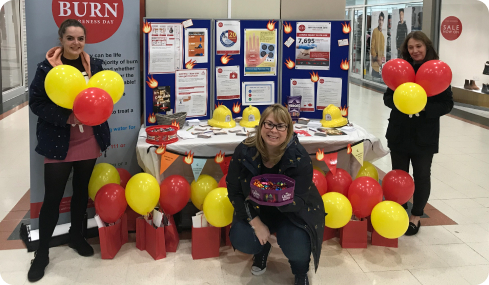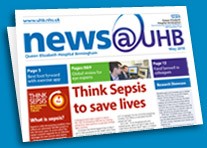Your views

Your feedback is vital to us as we continue to increase the quality of our services.
You are here:
Date: 27 January 2025
Time: 16:50

UHB burns experts reach out to local community
Story posted/last updated: 22 October 2019
In honour of National Burn Awareness Day on 16 October, experts from the burns specialist team at University Hospitals Birmingham were out in the community giving advice on how to prevent and treat burns and scalds.
Nurses and medics based at the Regional Burns Centre at the Queen Elizabeth Hospital Birmingham (QEHB) were on hand for shoppers at Northfield Shopping Centre raising awareness of burn injuries, educating on burn prevention and how to administer first aid in the event of burns.
This year the team aimed to provide the local community in which it serves with the knowledge of how to treat a burn injury when it occurs.
The Children’s Burns Trust in partnership with the British Burns Association are promoting the SafeTea Campaign which aims to prevent serious burns from mugs of hot tea or coffee, and to ensure parents and carers know how to give burns first aid.
Hot drinks are the most common cause of scald injury for children and older people but could also affect adults at home and in the work place.
Laura Presley-Hague, Divisional Clinical Educator said: “The majority of burns occur in the household but most can be prevented.
“By raising more awareness of how to do this will make a difference.”
Facts and figures
- On average, 30 babies and toddlers go to the hospital with a hot drink burn every day.
- 60% of all under-three paediatric burn attendances to A&E departments are due to hot drink burns.
- 590 children a month require admission to an NHS Burns Service following a severe burn or scald injury.
- 4,609 children were so badly burned they were admitted to a to a NHS specialist burns service in 2018. That is over 12 toddlers every day.
- The most common place of injury for children and the elderly is the home. For adults it is the workplace.
- Irons and hair straighteners take longer to cool down than you think. More than 662 children aged between birth and 14 years old were treated for burns from these appliances in 2018.
First Aid
Knowing how to administer appropriate first aid immediately following a burn or scald can make all the difference in both recovery times and the severity of scarring.
Two important things to remember are:
Cool, Call, Cover
- Cool the burn with running cool or lukewarm running water for 20 minutes, and remove all clothing and jewellery near the wound, including nappies on babies (unless melted or firmly stuck to the wound)
- Call for help for any burn larger than a 50p coin - 999, 111 or local GP for advice
- Cover with cling film or a sterile, non-fluffy dressing or cloth. Make sure the patient is kept warm
Stop, Drop, Roll
"Stop, Drop and Roll" is used when clothing catches fire. It is important to know when to do this. Children can get confused about when to stop, drop and roll. Those who do not have a good understanding of stop, drop and roll will sometimes do this if they burn a finger or need to get outside when the smoke alarm sounds.
Only use stop, drop and roll when clothing catches fire.

Getting here
Information about travelling to, staying at and getting around the hospital.

Jobs at UHB
A great place to work. Learn why.
news@UHB


RSS feed
Subscribe to our news feed


